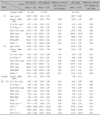Abstract
Objective
The purpose of this study was to evaluate how airway changes influence facial growth during puberty in Korean children.
Methods
Thirty-six patients aged 9 to 11 (mean age: 10.7 years) were selected. Cephalograms and hand-wrist x-rays were taken at pre-treatment (T1) and post-treatment (T2). The sample was divided into narrow (5.2 - 8.6 mm, AW-Narrow), medium (8.9 - 11.5 mm, AW-Medium), and wide (11.7 - 16.0 mm, AW-Wide) groups according to the airway width at T1. Cephalometric measurements at T1, T2 and growth from T1 to T2 were compared between groups.
Results
The degree of increase in airway size in each group was 4.55 mm, 3.84 mm and 1.94 mm in the AW-Narrow, AW-Medium, and AW-Wide groups, respectively. Moreover, the differences were statistically significant. The significant smallest posterior facial height was found in the AW-Narrow group at T1. For the growth values from T1 to T2, the AW-Narrow group showed significantly larger values of PFH/AFH, facial axis, ANS (T1 - T2), and Gn (T1 - T2) than the AW-Medium group.
Conclusions
The compensational changes in the airway width and facial growth were found in the narrow group. Surgical approach of the airway to prevent unfavorable facial growth in these years of age should be carried out, but with careful deliberation because these problems may be improved naturally.
Figures and Tables
 | Fig. 1
A and B, Airway width, anteroposterior measurements and cervical vertebral maturation by the concavity depth of the 4th cervical vertebra19 used in this study. 1. Upper airway width: The shortest distance between the posterior border of the soft palate and anterior border of adenoid; 2. A point-N perpend: distance from point A to the line perpendicular to FH plane passing through nasion; 3. N-A-Pog angle: angle formed by nasion, A point and pogonion; 4. Pog-N perpend: distance from pogonion to the line perpendicular to FH plane passing through nasion; 5. Facial Axis: angle formed by N-Ba line and Gn-Pt line; 6. Anterior facial height (AFH): distance between nasion and menton; 7. Posterior facial height (PFH): distance between sella and gonion; 8. PFH/AFH: ratio of PFH to AFH; 9. FMA: angle formed by FH plane and mandibular plane. C, Superimposition of lateral cephalograms taken between T1 (Initial) and T2 (Debonding) show the direction of growth of maxilla and mandible. 10. Angle between N-Ba line and the direction of growth of Gn; 11. Angle between N-Ba line and the direction of growth of ANS; 12. Angle between the direction lines of ANS(s) and Gn(s). |
References
1. Moyers RE. Etiology of malocclusion, in Handbook of orthodontics. 1988. Chicago: Year Book Medical Publishers, Inc.;21.
2. Behlfelt K, Linder-Aronson S, McWilliam J, Neander P, Laage-Hellman J. Cranio-facial morphology in children with and without enlarged tonsils. Eur J Orthod. 1990. 12:233–243.

4. Proffit WR, Fields HW Jr, Sarver DM. Contemporary orthodontics. 2007. 4th ed. St. Louis: Mosby Year Book Inc.;154–158.
5. Cheng MC, Enlow DH, Papsidero M, Broadbent BH Jr, Oyen O, Sabat M. Developmental effects of impaired breathing in the face of the growing child. Angle Orthod. 1988. 58:309–320.
6. de Freitas MR, Alcazar NM, Janson G, de Freitas KM, Henriques JF. Upper and lower pharyngeal airways in subjects with Class I and Class II malocclusions and different growth patterns. Am J Orthod Dentofacial Orthop. 2006. 130:742–745.

7. Hwang YI, Lee KH, Lee KJ, Kim SC, Cho HJ, Cheon SH, et al. Effect of airway and tongue in facial morphology of prepubertal Class I, II children. Korean J Orthod. 2008. 38:74–82.

8. Lessa FC, Enoki C, Feres MF, Valera FC, Lima WT, Matsumoto MA. Breathing mode influence in craniofacial development. Braz J Otorhinolaryngol. 2005. 71:156–160.

9. Linder-Aronson S. Effects of adenoidectomy on mode of breathing, size of adenoids and nasal airflow. ORL J Otorhinolaryngol Relat Spec. 1973. 35:283–302.

10. McNamara JA Jr. Influence of respiratory pattern on craniofacial growth. Angle Orthod. 1981. 51:269–300.

11. Tourne LP. The long face syndrome and impairment of the nasopharyngeal airway. Angle Orthod. 1990. 60:167–176.

12. Vig KW. Nasal obstruction and facial growth: the strength of evidence for clinical assumptions. Am J Orthod Dentofacial Orthop. 1998. 113:603–611.

13. Handelman CS, Osborne G. Growth of the nasopharynx and adenoid development from one to eighteeen years. Angle Orthod. 1976. 46:243–259.
14. Jaw TS, Sheu RS, Liu GC, Lin WC. Development of adenoids: a study by measurement with MR images. Kaohsiung J Med Sci. 1999. 15:12–18.
15. Vilella Bde S, Vilella Ode V, Koch HA. Growth of the nasopharynx and adenoidal development in Brazilian subjects. Braz Oral Res. 2006. 20:70–75.

16. Woodside DG, Linder-Aronson S, Lundstrom A, McWilliam J. Mandibular and maxillary growth after changed mode of breathing. Am J Orthod Dentofacial Orthop. 1991. 100:1–18.

17. Zettergren-Wijk L, Forsberg CM, Linder-Aronson S. Changes in dentofacial morphology after adeno-/tonsillectomy in young children with obstructive sleep apnoea--a 5-year follow-up study. Eur J Orthod. 2006. 28:319–326.

18. Fishman LS. Radiographic evaluation of skeletal maturation. A clinically oriented method based on hand-wrist films. Angle Orthod. 1982. 52:88–112.
19. Lee KH, Hwang YI, Kim YJ, Park YH, Baek SH, Cha KS. Skeletal maturation associated with the fourth cervical vertebra and menarcheal timing. Korean J Orthod. 2008. 38:52–59.

21. Dahlberg G. Statistical methods for medical and biological students. 1940. New York: Interscience;1–140.




 PDF
PDF ePub
ePub Citation
Citation Print
Print




 XML Download
XML Download